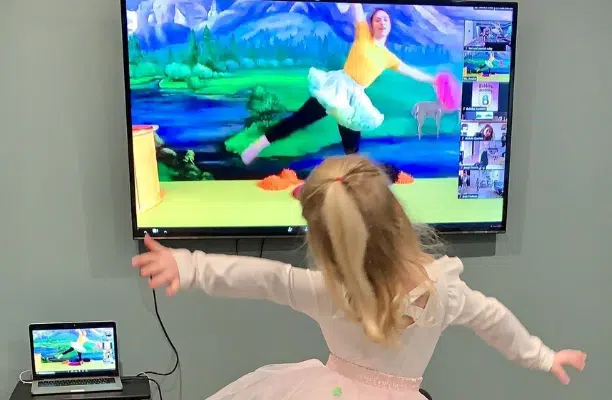“Before a child talks they sing. Before they write they draw. As soon as they stand they dance. Art is fundamental to human expression.” –Phylicia Rashad.
One of the most challenging parts of moving our classes online was finding the answer to to the question “how do we take our interactive, high touch, follow-their-lead curricula and translate that to the screen when we are each alone, in our own spaces, without access to all of the same materials; how do we make something passive into something active?”. I immediately saw the opportunity for Bubble Ballet to really shine. As a dancer myself, I’ve always been interested in how we teach children to move. It isn’t always true that a three year old has the attention span or body awareness to stand up straight at a ballet barre and point their toes in each direction – that isn’t helpful or necessarily healthy for growing bodies. Instead our goal is to give them tools, vocabulary, and motor skill practice to build up to that when it IS developmentally appropriate. Here’s a little “backstage” look at how we teach Bubble Ballet virtually and why it works for us and for our kids!
The class is based on verbal instruction and modeling the movements with the kids. The verbal instruction gives them a vocabulary of movement, but for kids in our age range (1-5), the way they learn is perceptual. First they have to observe the movement by watching another body do the task; then they have to interpret it by creating a mental image of how that will work with their own body; and finally they can respond physically. You can tell a child to “march” as much as you want but until they have a physical example, they have no context.
Bubble Ballet is structured the same way each class and always uses a creative theme as a through-line for the week. Class is divided into three sections: Body Identification/Open Dance, Everyday Stretches/Songs, Theme Exploration. The first two-thirds remain very similar in each class. Repetition is SO important for little kids. With repetition, we develop muscle memory: the build up of procedural memory that your brain can then instruct your body to do without much effort over time. In ballet we are working primarily on gross motor skills – which vary from child to child and develop as you grow. “Helping a child succeed in gross motor tasks requires patience and opportunities for a child to practice desired skills.” This article from The Encyclopedia of Children’s Health breaks down gross motor skill development by expected ages and gives more ideas on how to work/practice to reach those goals.
Body Identification/Open Dance
We start the class with a body identification, oftentimes “Head, Shoulders, Knees, and Toes”. Children starting at about 15 months can identify body parts, and with identification comes awareness! Once we’ve named those parts and begun to move them, we do our Open Dance. I like to pick songs that interact with our daily theme that also have a fun, uptempo beat connecting our dancing to music for the first time that day. The Open Dance uses gross motor movements (such as bouncing, swaying, marching, and spinning) that we know our little ones are working towards and mastering. Taking inspiration from Anne Green Gilbert’s “The Brain Dance”, we incorporate moves that are tactile, core-distal, cross-lateral, and vestibular to begin our day’s engagement with the brain and body. To learn more about the Brain Dance, click here. Whether a child actually follows my movement varies, the only thing I ask of them and their families is to keep moving for the whole song.
Everyday Stretches/Songs
Then we sit down on the ground to do our stretching. Warm-ups and stretching are such a big part of ballet and dance classes no matter your age or level, so structuring class like this sets up that foundation for the future. We have songs that we sing everyday – our Toes Song to practice pointing and flexing, our Hello song where we wave our feet hello and use our bodies to express how we’re feeling that day, and our Ballet song that uses our beginner ballet techniques and vocabulary (pliés, tendus, etc.). These are the moments that stick with our children because they know to expect it, they hear it frequently, and they learn how to practice it on their own. Nothing makes me smile more than when I get a message from a mom saying “My kid has been singing the ballet song all day!” and I get that message a lot.
Theme Exploration
After this, we break off and let each class be individual. This is where we learn new moves, try new activities, and sing new songs. I pull from my history in creative movement and ballet, as well as modern dance, jazz, even yoga and gymnastics to let the kids really play! We use themes as a through-line to tap into their imaginations.We take stories, characters, and concepts that are already familiar to them and create a dance playground to explore new ideas. We talk about port de bras (moving and posing our arms) as flying like butterflies or walking across a balance beam as walking the plank on a pirate ship. It becomes not only about the movement, but about how the movement interacts with the world. We get to be silly while we learn. Mr. Rogers said, “Play is the work of childhood.”
I frequently think of ballet as a discipline. For adults and older children studying ballet, it is very precise and uses a lot of muscles that are still developing in our little ones. So maybe our ballet class isn’t classical, but it is how to get our little ones moving and excited about it. Whether they are just observing or actively dancing along, they are taking in the information at the pace their brains and bodies need.
Join us in Bubbles ballet with Miss Amelia! Click here for the schedule.

Amelia Bell
Amelia’s been moving and grooving from day one. Her parents once told her that as a child she “wasn’t content until she could walk on her own.” Walking quickly turned into dancing, and she’s never stopped. Originally from Houston, Texas, Amelia spent her childhood trying to do anything she considered “artistic” until finally finding her passion in theatre and dance. She graduated from Northwestern University where she was a Theatre major, Dance minor, and graduated with a certificate in Music Theatre.
Working at Bubbles is a dream come true! The mixture of imagination, adventure, art, and music is perfect for Miss Amelia’s energetic and creative spirit. She has been working with young children since she was a teenager, and loves the opportunity Bubbles gives to combine her love of children with her love of the arts. When not working, she can be found on stage performing, teaching herself how to play musical instruments, and baking treats for friends!
